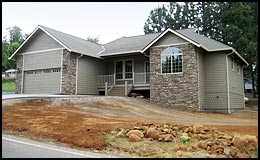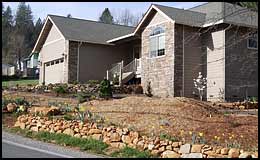
ANALYZING Y0UR SITE![]()
![]()
Motivation
![]() Why Natives
Why Natives
![]() Garden Goals
Garden Goals
Site Preparation
![]() Site Analysis
Site Analysis
![]() Site Plan
Site Plan
![]() Hardscapes
Hardscapes
Plant Selection
![]() Which Native
Which Native
![]() Planting Hints
Planting Hints
![]() Suggested Plants
Suggested Plants

There may be problems to deal with after new house construction. Property is often left barren with topsoil scraped away and a residue of gravel and concrete. Slopes may be too steep for planting and comfortable walking. Rocks may be found hidden below the surface where the builder stashed them to get them out of the way. The few plants that remain on the site are likely to be weeds, but a newcomer to the area may not be able to identify them. Downspouts may discharge rainwater in inconvenient places.

This is the same property one-and-a-half years later. A terrace was built near the front entry. Several mounds were installed and a stacked-rock wall was built from rocks found on the site and some donated by a neighbor. Dwarf conifers (non-natives grown in Oregon) were planted in front of the house and the native garden was started at the right side, out of the picture. Bark chips and ground-up limbs from pine tree trimming were used for mulch. A small grove of pine trees and one small-leaved oak were retained.
Site Analysis
There is more to planting a native garden than digging a hole and dropping in a plant. It is desirable to spend a year observing your site to gain insight on how to proceed. There is much to consider.
-
Observe the sunny and shady areas. How do they change during the day and through spring, summer, fall and winter? What microclimates can you identify (small areas where plants with special needs might thrive)?
-
Study the pattern of water. Which areas are moist and which are dry? Where does the runoff go when it rains? When do you have frost? What happens if it snows?
-
Look at the contours of the land. Are there steep areas that are likely to erode? Do you need to terrace some areas to make them usable? Where is the highest ground? (Higher ground is likely to be best for fruit trees and sensitive plants.) Are there rocks or other features that you want to preserve? What are the natural pathways that humans will use? Is there a place where deer habitually cross the land?
-
Note the prevailing wind. Do you need to consider windbreaks? Will some areas be too windy for delicate plants?
-
Analyze the soil. You can have a soil analysis done, do a simple one yourself with a purchased kit, or talk with a nursery to find out what is generally lacking in foothill soils. Think about how to improve your soil. Locate sources of mulch and other supplies and how to transport them when you are ready for them.
-
Do a percolation test. Dig a hole 8 to 12 inches wide and deep and fill it with water. Monitor how long the water takes to soak in. If it takes more than four hours, plants will have a big problem trying to grow there. Natives, especially, need good drainage. You will have more success if you plant in raised beds or on mounds. Repeat the test in various parts of the yard.
-
Inspect the existing plants. What is growing well, what should be pruned and what do you want to remove? Blackberries, poison oak and flammable shrubs are likely to be problems in the foothills. Are there shrubs that provide a fire-ladder into trees or under the eaves of the house?
-
Note needs that are specific to your site. Where are your sewer and leach lines located? Do you want to increase privacy, screen out sounds, and improve fire safety? Is your sun exposure adequate for solar panels? Do you need more shade trees to control summer heat? What else?
-
View your yard from the interior of your house. What do you want to see when you look outside? Which rooms would benefit from a garden view? Do you have distant views that you will not want to block as plants grow?
-
Look around your neighborhood. What is the dominant plant community (grasslands, oak and pine, conifer forest)? What plants are native to the area? What plants do you see that you particularly like? What natural materials occur that you might like to utilize in your design? What problems do your neighbors frequently encounter? Where do deer hang out and how might you discourage them from garden areas if you desire to?
-
Consider your preferences and lifestyle. Do you prefer a formal or informal look? Do you entertain outdoors? Do you have children that need play space or pets that will be outside? Do you want a quiet area for contemplation and reading? Do you want flowers, vegetables and fruit trees? Do you want to include water features or garden sculpture? Are you interested in having an attractive yard for the passersby to view? What else might you think of?
- Explore resources within your community. Go to Native Plant Society meetings and flower walks, attend Master Gardener workshops, go on garden tours, visit local nurseries, check out library books on native plant gardens, explore topics on the Internet and take advantage of any opportunities that arise to learn about gardening with native plants. Besides gaining information and ideas, you will meet other people who share your interest.